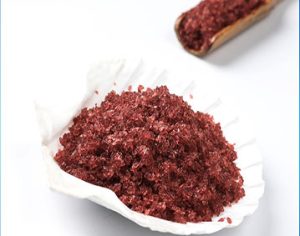Molecular formula:Co(NO3)2·6H2O 
Molecular weight:291.03
Features
Red crystal or grain, easy in moisture, Specific Density:1.88, Melting Point: 55-56°C,it is easily dissolved in water, ethanol and acetone. it has oxidizing property. It will burn or explode once in contact with organic chemicals. It has pungency to skin.
| NO | Item | Specification | ||
| 1 | Co(NO3)2·6H2O, % | ≥99.0 | ≥98.5 | ≥98.0 |
| 2 | Water insoluble matter, % | ≤0.005 | ≤0.01 | ≤0.1 |
| 3 | Cl, % | ≤0.005 | ≤0.001 | —– |
| 4 | SO4, % | ≤0.005 | ≤0.02 | —– |
| 5 | Fe, % | ≤0.0005 | ≤0.001 | ≤0.05 |
| 6 | Ni, % | ≤0.005 | ≤0.5 | —– |
| 7 | Zn, % | ≤0.05 | ≤0.1 | —– |
| 8 | Mn, % | ≤0.005 | ≤0.02 | —- |
| 9 | Cu, % | ≤0.002 | ≤0.01 | —– |
| 10 | Sulfide insoluble, % | ≤0.1 | ≤0.5 | —– |
| 11 | Appearance | Red crystal | Red crystal | Red crystal |
Packaging Sizes
25kg net. Double plastic bags lined plastic woven sack.
Storage
Stored in cool and dry warehouse; Keep away from flame and heat.
Cobalt Nitrate Application:
Cobalt nitrate, with the chemical formula Co(NO3)2, is a versatile compound that finds numerous applications across various industries. This highly soluble, crystalline substance is known for its unique properties and has gained significant importance in diverse fields. In this description, we will explore the applications of cobalt nitrate and highlight its significance in different sectors.
1.Catalysts and Chemical Industry: Cobalt nitrate plays a crucial role as a catalyst in several chemical reactions. It is used in the production of numerous organic compounds, including pharmaceuticals, dyes, and pigments. The compound exhibits excellent catalytic properties, enabling the synthesis of complex molecules in a more efficient and economical manner. Its application as a catalyst extends to the petroleum industry, where it aids in refining processes and hydrogenation reactions.
2.Agriculture and Animal Nutrition: Cobalt nitrate is an essential component in agricultural practices and animal nutrition. It is used as a source of cobalt, an essential trace element required for the growth and development of plants and animals. Cobalt is a vital component of vitamin B12, which is crucial for the proper functioning of the nervous system and the synthesis of red blood cells. Cobalt-deficient soils are supplemented with cobalt nitrate to ensure optimal crop growth and increase agricultural yields.
3.Electroplating and Metal Finishing: Cobalt nitrate is widely employed in electroplating processes and metal finishing applications. It serves as a source of cobalt ions, which are used to deposit a protective and decorative cobalt layer on various substrates. The electroplated cobalt coatings exhibit high hardness, corrosion resistance, and improved wear characteristics. These properties make cobalt-plated materials ideal for applications in the automotive, aerospace, and electronics industries.
4.Lithium-ion Batteries: Cobalt nitrate is an integral component in the production of cathode materials for lithium-ion batteries. The compound is used in the synthesis of lithium cobalt oxide (LiCoO2), a widely utilized cathode material known for its high energy density and stability. LiCoO2 batteries are commonly found in portable electronic devices, electric vehicles, and renewable energy storage systems. The demand for cobalt nitrate in the battery industry is expected to increase as the demand for lithium-ion batteries continues to grow.
5.Analytical Chemistry: Cobalt nitrate is employed in various analytical techniques and laboratory experiments. It is used as a reagent for the detection and quantification of several compounds and elements. Cobalt nitrate is particularly useful in colorimetric assays and spectrophotometric analyses, where it forms complexes with certain substances, leading to characteristic color changes. These reactions aid in qualitative and quantitative analysis in fields such as environmental monitoring, pharmaceutical research, and water quality testing.
6.Other Applications: Cobalt nitrate finds additional applications in industries such as ceramics, glass manufacturing, and pyrotechnics. In ceramics, cobalt nitrate is used as a colorant to achieve blue hues in glazes and pottery. In the glass industry, it serves as a reducing agent and a source of cobalt oxide for tinting and coloration. Cobalt nitrate’s oxygen-releasing properties make it suitable for pyrotechnic applications, where it acts as an oxidizing agent in fireworks and flares.
7.In conclusion, cobalt nitrate is a versatile compound with a wide range of applications in catalysts, agriculture, electroplating, batteries, analytical chemistry, and various other industries. Its unique properties and versatility make it a valuable component in numerous processes and products. As technology and industry continue to advance, the demand for cobalt nitrate is expected to grow, further highlighting its significance in the global market.
How do you storage this product?
This product should be stored in a dry and clean warehouse. Keep away from fire and heat sources. Keep out of direct sunlight and keep the container tightly closed. It should be stored separately from flammable and combustible materials, reducing agents, sulfur, phosphorus, metal powder, etc. Mixed storage and mixed transportation are forbidden. When handling the workers should be lightly loaded and unloaded to prevent damage to packaging and containers.
Spill emergency treatment?
Isolate the leakage pollution area immediately, and set warning signs around it. It is recommended that emergency personnel wear gas masks and chemical protective clothing. Do not directly contact the spill products, do not let the spill contact with combustible substances (wood, paper, oil, etc.), and absorb it with sand, vermiculite or other inert materials, and then collect and transfer to a safe place. In case of a large amount of leakage, collect and recycle or discard after harmless treatment.
Protective measures?
Respiratory system protection: When the concentration in the air is high, a self-priming filter dust mask should be worn. And wear self-contained breathing apparatus if necessary.
Eye Protection: Wear chemical safety goggles.
Body protection: wear tape anti-virus clothing.
Hand Protection: Wear rubber gloves.
The emergency measures.
Skin contact: Take off contaminated clothing, rinse thoroughly with running water immediately.
Eye contact: Immediately lift the eyelids and rinse with running water or saline for at least 15 minutes. Seek medical attention.
Inhalation: Get away from the scene to fresh air. Give artificial respiration if necessary. Seek medical attention.
Ingestion: If swallowed by mistake, drink plenty of warm water, induce vomiting, seek medical attention.
